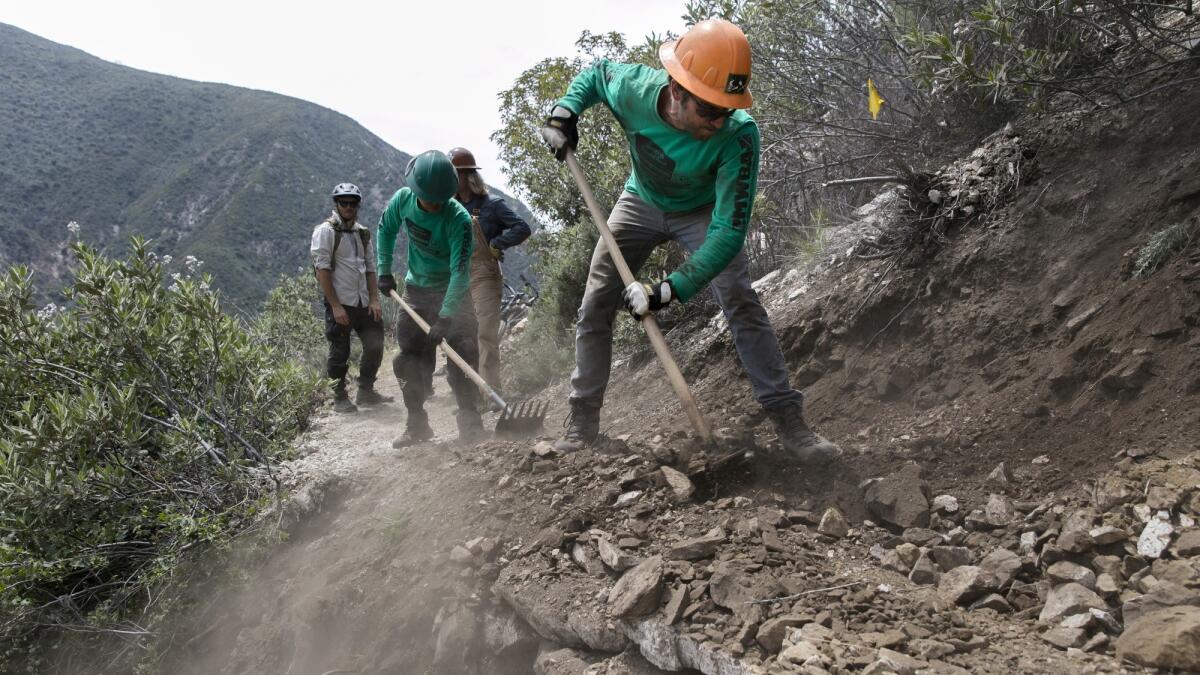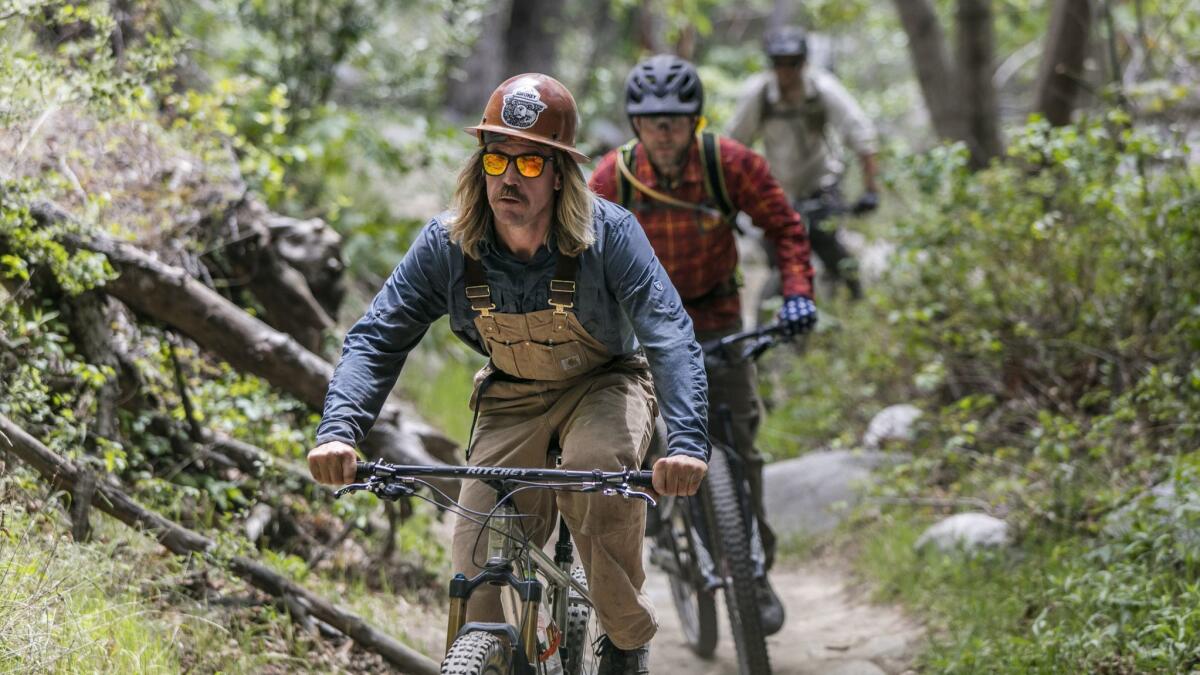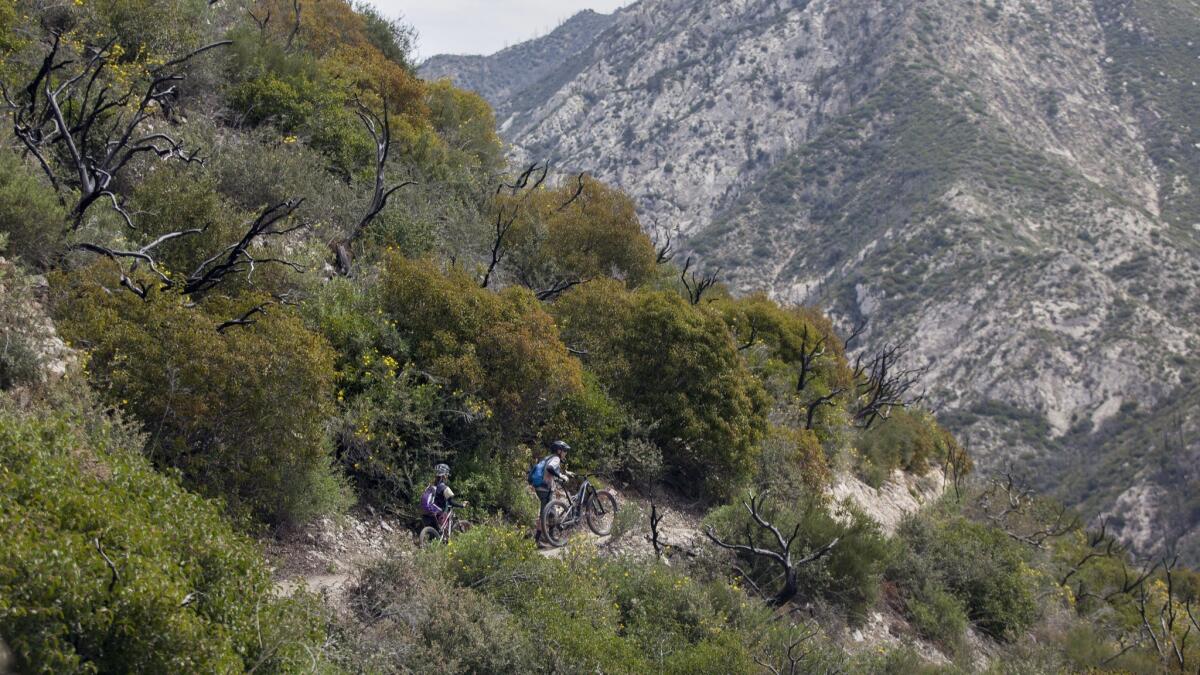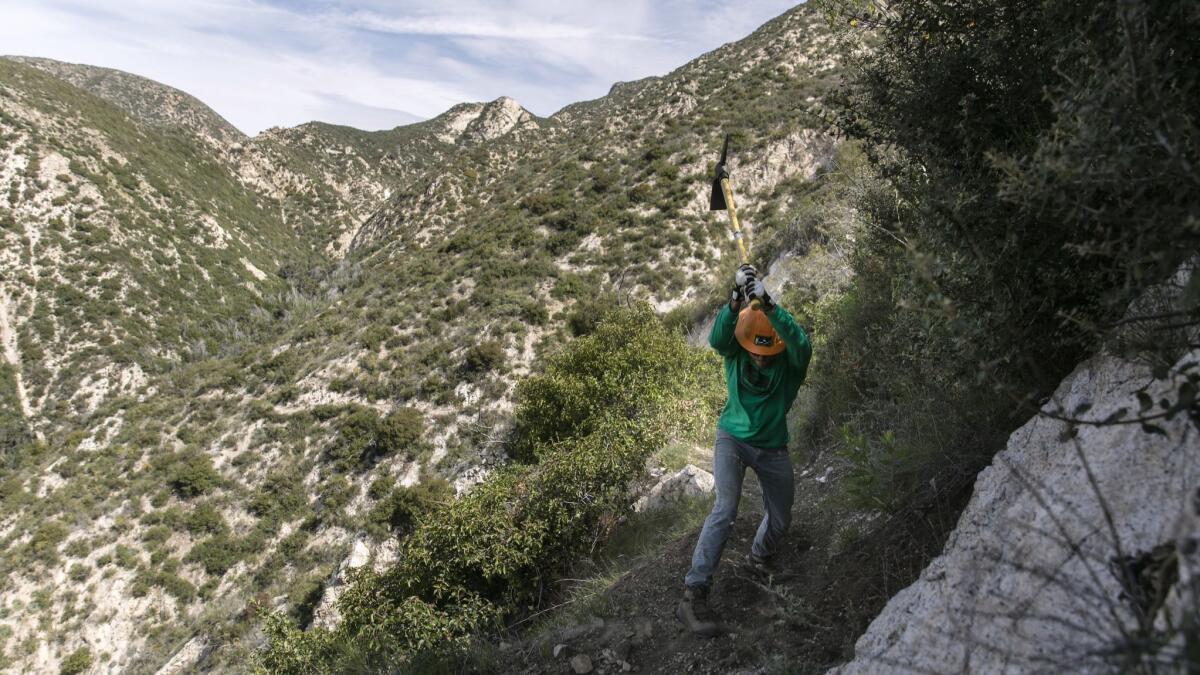Closed for nearly a decade, the historic Gabrielino Trail is nearly restored — thanks to mountain bikers

Erik Hillard has always believed the best way to know a rugged trail is to bike it. But for nearly a decade, the historic Gabrielino Trail in the peaks above La Cañada Flintridge has been all but unknowable to mountain bikers.
The 2009 Station fire and the rainy season that followed it rendered much of a 26-mile stretch of the trail impassable.
Hillard, and a team of volunteers, have been working to change that.
It’s a landscape-sized job in the San Gabriel Mountains, where about 100 people have spent spare days and weekends recarving a path wide enough for only one bike at a time that climbs and dips under canopies of aspen and oak, past rock overhangs and along cliffs with sweeping views and no guardrails.
But the U.S. Forest Service says the yearlong volunteer campaign holds the best hope for reopening the nation’s first National Recreation Trail — and keeping peace between mountain bikers and hikers in the increasingly crowded backcountry of the Angeles National Forest’s San Gabriel Mountains National Monument.
“This is an unforgiving mountain range, where nothing is flat and wildfires and floods are routine,” said Hillard, 43, a spokesman for the Mt. Wilson Bicycling Assn. “And without volunteer efforts, these trails would stay closed.”
At daybreak on a recent Sunday, 30 riders from his group and the Concerned Off-road Bicyclists Assn., clad in helmets, shin guards and work gloves, rolled out to a 10-mile stretch that was nearly swept away by torrential rains and mudslides after the largest fire in Los Angeles County history.

Without this eclectic mix of retirees, professionals and students, Forest Service officials say, the tasks ahead — chopping up fallen trees, rolling boulders aside and scraping rocks and mud off the path that served as a Native American trade route — would have been deferred for years by the chronically underfunded agency, which long ago dismantled its own full-time paid trail crew.
That’s because the Forest Service has been absorbing the rising cost of fighting fires and reducing wildfire threats to communities into its regular budget by shrinking other programs, said Jamahl Butler, acting district ranger for the area.
“This project is a good example of the way we like to see collaboration done,” Butler said. “I’m impressed with their work and happy to have their support.”
The management plan for the San Gabriel Mountains National Monument released last month calls for more collaborative efforts with volunteer groups going forward.
The final closed sections of the Gabrielino Trail are expected to reopen to the public by summer’s end, the Forest Service said.

Restoring the trail achieves multiple aims for mountain bikers — not only does it provide them more miles to ride, but they believe it bolsters their stature among trail users, helping ensure their continued access to the climbs and descents of the San Gabriel Mountains.
There’s reason mountain bikers are interested in reputation-burnishing.
With their knobby tires, mountain bikes can carve ruts into trails, trample vegetation, widen paths and accelerate erosion, especially after rains. Their downhill speeds also can startle other trail users.
The Mt. Wilson Bicycling Assn. and other groups have worked to educate riders on reducing their environmental impact. They also have worked to maintain and repair trails.
“Mountain bikers have traditionally been unwanted in public lands,” Hillard said.
“One of the main reasons for all this work is to show how much trails through forests like this one mean to us — and to others,” he said.
The effort is being conducted with $25,000 from the outdoors retailer REI and $10,000 from Southern California Edison Co. An additional $100,000 from the Forest Service will cover the costs of having contract workers install retaining walls in certain remote areas, officials said.
“When we began, it was hard to find a trace of this historic trail in some places,” recalled Steve Messer, 54, president of Concerned Off-road Bicyclists. “Since then, we’ve cut up more than 100 trees, removed countless boulders and reestablished sections of trail where the hillsides above and below them had collapsed. We’ve also created drainage structures to steer rain off the trail and reduce erosion, and bolstered ruts with soil and rocks.”
Messer is considering nominating the path for National Historic Trail status because of numerous remnants of buildings and walls made out of rock, mortar and rebar in the 1930s by the Civilian Conservation Corps.
In the meantime, he said, “We have a lot more work ahead of us.”
The volunteers gathered at the Switzer picnic area, about 15 minutes off the 210 Freeway in La Cañada Flintridge, and headed out on their full-suspension bikes to damaged sections of trail.
They worked in small groups, hacking at dry brush with shears and folding saws, attacking displaced boulders with pickaxes and smoothing a path about 18 inches wide with rakes.
After a five-minute breather, they moved to the next rock slide a few yards away, filling the air with the thunk of shovels.
At a switchback, Brad Moore, 29, was swinging a heavy-duty hoe and ax known as a Pulaski to demolish remnants of a mudslide and contour sections of trail that had been eroded by runoff.
Moore, a mechanical engineer at the nearby Jet Propulsion Laboratory in La Cañada Flintridge, wiped the sweat from his stinging eyes, smiled and said, “Man, I love this tool — it makes me feel like a sourdough in the Old West searching for gold and fulfillment.”

Their progress on the Gabrielino made a good impression on passersby, including Susan Campo, 70, a hiker who crossed paths with the mountain bikers on a stretch of twisting terrain skirting steep canyon walls near the 50-foot Switzer Falls.
“Great work up here — keep it up!” said Campo, who, like many other hikers that day, had strode past the “trail closed” signs posted by the Forest Service. “I don’t have to crawl on my hands and knees under fallen trees anymore.”
About 1 p.m., trail boss Matt Baffert, 37, a professional carpenter, signaled it was time to call it a day. Hungry, tired and sore, the volunteers coasted down to the picnic area parking lot.
UPDATES:
10:55 a.m.: This article was updated to clarify that the Gabrielino Trail in not in a designated wilderness area.
This article was originally published at 5 a.m.
More to Read
Sign up for Essential California
The most important California stories and recommendations in your inbox every morning.
You may occasionally receive promotional content from the Los Angeles Times.











